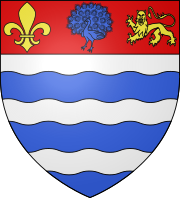Newark, England
| Newark-on-Trent | |
|---|---|
 Market Square, Newark-on-Trent town centre |
|
 Arms of Newark |
|
| Newark-on-Trent shown within Nottinghamshire | |
| Population | 27,700 (2011) |
| OS grid reference | SK801537 |
| District | |
| Shire county | |
| Region | |
| Country | England |
| Sovereign state | United Kingdom |
| Post town | NEWARK |
| Postcode district | NG24 |
| Dialling code | 01636 |
| Police | Nottinghamshire |
| Fire | Nottinghamshire |
| Ambulance | East Midlands |
| EU Parliament | East Midlands |
| UK Parliament | |
Newark-on-Trent or Newark /ˈnjuːək/ is a market town in Nottinghamshire in the East Midlands of England. It stands on the River Trent, the A1 (on the route of the ancient Great North Road), and the East Coast Main Line railway. The origins of the town are possibly Roman as it lies on an important Roman road, the Fosse Way. The town grew around Newark Castle, now ruined, and a large marketplace, now lined with historic buildings, and was a centre for the wool and cloth trade. In the English Civil War, it was besieged by Parliamentary forces and had to be relieved by Prince Rupert in a battle known as the Relief of Newark.
The estimated population in 2007 was 26,330, increasing to 27,700 at the 2011 census.
The origins of the town are possibly Roman due to its position on an important Roman road, the Fosse Way. In a document which purports to be a charter of 664, Newark is mentioned as having been granted to the Abbey of Peterborough by Wulfhere. An Anglo-Saxon pagan cemetery, used from the early 5th to the early 7th centuries, has been found in Millgate, in Newark, close to both the Fosse Way and the River Trent in which cremated remains were buried in pottery urns.
...
Wikipedia

